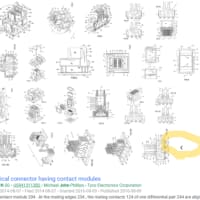US10294371
"When fibres become refined under applied energy they become fibrillated as the cell walls are broken and torn into attached strips, i.e. into fibrils. If this breakage is continued to separate the fibrils from the body of the fibre, it releases the fibrils. The breakdown of fibres into microfibrils is referred to as “microfibrillation”. This process may be continued until there are no fibres left and only fibrils of nano size (thickness) remain.
If the process goes further and breaks these fibrils down into smaller and smaller fibrils, they eventually become cellulose fragments or nano-gel. Depending on how far this last step is taken some nano-fibrils may remain amongst the nano-fibril gel. The breakdown to primary fibrils may be referred to as “nano-fibrillation”, where there may be a smooth transition between the two regimes. The primary fibrils form in an aqueous environment a gel (meta stable network of primary fibrils) which may be referred to as “nano-fibrillar gel”. The gel formed from the nano-fibrils can be considered to contain nanocellulose.
Nano-fibrillar gels are desirable as they usually contain very fine fibrils, considered to be constituted in part of nanocellulose, showing a stronger binding potential to themselves, or to any other material present, than do fibrils which are not so fine or do not exhibit nanocellulosic structure.
The achievable fineness with conventional refiners however is limited. Also, a number of other apparati for breaking down particles are not capable of breaking down cellulose fibres to nano-fibrils, such as fluffers mentioned in US 2001/0045264, which are only capable of separating given size fractions of fibres from each other. "
繊維が、加えられたエネルギー下で精砕されると、細胞壁が破壊され、付着した細片、すなわち、フィブリルに引き裂かれるのにつれて、それらはフィブリル化される。この破壊が、繊維の本体からフィブリルを分離するように継続される場合、それにより、フィブリルは放出される。繊維のミクロフィブリルへの微細化は、「ミクロフィブリル化」と呼ばれる。このプロセスは、残った繊維がなくなり、ナノサイズ(太さ)のフィブリルだけが残存するまで、継続され得る。
【0011】
このプロセスがさらに進み、これらのフィブリルをますます小さいフィブリルに微細化する場合、それらは最終的に、セルロースの断片またはナノゲルになる。この最後のステップがどの程度まで時間を要するかに依存して、一部のナノフィブリルは、ナノフィブリルゲルの中に残存し得る。一次フィブリルへの微細化は、「ナノフィブリル化」と呼ぶことができ、この2つの形態間で円滑な移行があり得る。一次フィブリルは、「ナノフィブリルゲル」と呼ばれ得るゲル(一次フィブリルのメタ安定網状組織)を水環境で形成する。ナノフィブリルから形成されるゲルは、ナノセルロースを含有すると考えることができる。
【0012】
ナノフィブリルゲルは通常、一部ナノセルロースで構成されていると考えられる非常に微細なフィブリルを含有するので、それらは望ましく、それほど微細でないまたはナノセルロース構造を示さないフィブリルよりも、それら自体へのまたは存在する任意の他の材料へのより強い結合可能性を示す。
【0013】
しかし、従来の精砕機による達成可能な微粉度は、限定されている。また、粒子を微細化するためのいくつかの他の装置、例えば、所定の粒群の繊維を互いに分けることができるだけである、US2001/0045264に記載された毛羽立て機(fluffer)などは、セルロース繊維をナノフィブリルに微細化することができない。
WO2016145368
"As discussed above, the casting of a magnesium alloy including one or more high- melting-temperature elements in magnesium can result in permanent, high-melting- temperature, intermetallic precipitates in addition to non-permanent, low-melting- temperature, intermetallic phases in an alpha phase. These high-melting-temperature intermetallic phases can form during the solidification of the melted mixture of magnesium and the alloy elements. For example, the casting of a magnesium alloy including at least 85 weight percent magnesium, between 5 and 11 weight percent aluminum, between 0.1 and 3 weight percent zinc, and between 0.05 and 0.3 weight percent manganese, between 0.6 and 1.5 weight percent neodymium, up to 100 ppm copper, and up to 175 ppm iron can result in high-melting-temperature NdMg intermetallics (e.g., NdMg cubic, cP2 CsCl type, melting point 800 °C; NdMg2, cubic, cF24 MgCu2 type, melting point 780 °C;) and low-melting-temperature intermetallic phases, such as aluminum containing intermetallic phases (e.g., MgnAl12). Although additional processing of the cast alloy can refine the size and arrangement of the low- melting-temperature intermetallic phases and the grains of a first-phase (i.e., an alpha phase), the high-melting-temperature intermetallic phases (such as NdMg) can remain thermally unrefined in the solid state (e.g., resolutioned and precipitated as innocuous fine particles). Accordingly, the high-melting-temperature intermetallic phases can be considered permanently part of the alloy as long as it stays in the solid state. These permanent, high-melting-temperature, intermetallic precipitates can be formed when the cooling rate during solidification is slow enough that precipitation occurs prior to the solidification of the phases containing primarily low-melting-temperature elements; e.g., Mg-rich alpha phase."
上記説明のように、マグネシウム中に1つ以上の高溶融温度元素を含むマグネシウム合金の鋳造により、α相における非永久的な低溶融温度金属間相に加えて、永久的な高溶融温度金属間析出物を生じさせることができる。これらの高溶融温度金属間相は、マグネシウムと合金元素の溶融混合物の凝固中に生じ得る。例えば、少なくとも85重量パーセントのマグネシウム、5〜11重量パーセントのアルミニウム、0.1〜3重量パーセントの亜鉛、及び0.05〜0.3重量パーセントのマンガン、0.6〜1.5重量パーセントのネオジム、最大100ppmの銅、及び最大175ppmの鉄を含むマグネシウム合金の鋳造により、高溶融温度NdMg金属間化合物(例えば、NdMg、立方体、cP2 CsCl型、融点800℃;NdMg2、立方体、cF24 MgCu2型、融点780℃;)、及び低溶融温度金属間相、例えば、金属間相を含むアルミニウム(例えば、Mg17Al12)が生じ得る。鋳造合金の追加の処理により、低溶融温度金属間相の大きさ及び配置並びに第1相(即ち、α相)粒子を微細化することができるが、高溶融温度金属間相(例えば、NdMg)は、(例えば、分解されて無害の微粒子として析出された)固体状態で熱的に微細化されずに残存し得る。従って、高溶融温度金属間相は、固体状態を維持する限り、合金の永久的な部分と見なすことができる。これらの永久的な高溶融温度金属間析出物は、凝固中の冷却速度が、主に低溶融温度元素を含む相;例えば、Mgリッチα相の凝固前に析出が起こるのに十分な遅さである場合に形成され得る。
US9580623
"Accordingly, as a device progresses toward miniaturization, a higher cleaning degree is required in the cleaning process. However, main constitutional elements of the conventional silicon-containing resist under layer film and main constitutional elements of the semiconductor apparatus substrate are both silicon in many cases. Therefore, if one wishes to selectively remove the resist under layer film by dry etching, wet etching using a hydrofluoric acid type peeling solution, etc., there is a problem that the semiconductor apparatus substrate is damaged because constitutional components of the resist under layer film are similar to that of the semiconductor apparatus substrate. In addition, there is another problem that if a silicon-containing resist under layer film is used as a mask to process an under layer film just under the same by dry etching, the silicon-containing resist under layer film is modified by the dry etching, thereby hardly removed by subsequent wet etching. "
このように、素子の微細化に伴い、洗浄工程に要求される清浄度は高くなってきている。しかしながら、従来のケイ素含有レジスト下層膜の主要構成元素と半導体装置基板の主要構成元素はいずれもケイ素の場合が多く、ドライエッチングやフッ酸系の剥離液を使用したウエットエッチングなどでレジスト下層膜を選択的に除去しようとしても、レジスト下層膜と半導体装置基板の構成成分が近似しているために、半導体装置基板にダメージを与えてしまうという問題があった。また、ケイ素含有レジスト下層膜をマスクとして直下の下層膜をドライエッチングで加工した場合、ドライエッチングによってケイ素含有レジスト下層膜が変質し、その後のウエットエッチングで除去しにくくなるという問題もあった。
WO2017079351
"Layerwise construction processes have excellent capability to construct freestanding, whole components rather than coatings from a variety of ductile metals including stainless steel alloys, aluminum alloys, titanium alloys, nickel -based alloys, and cobalt chrome alloys. In liquid-phase layerwise construction processes for metals such as PBF-L, PBF-E, and DED, the construction material transitions from a solid phase to a liquid phase (melting), then back to a solid phase (solidification). The energy source used for melting can be focused to a relatively small area of the material surface to be melted and as such can control the volume of material being melted to a relatively small volume. The small molten volume, being in contact with a large solid volume, has the capability to solidify in a relatively rapid manner. This rapid solidification is responsible for grain size refinement, supersaturation, and a match or an increase in mechanical properties when compared to wrought metal properties."
積層構築プロセスは、ステンレス鋼合金、アルミニウム合金、チタン合金、ニッケルベースの合金、及びコバルトクロム合金を含む様々な延性金属から、コーティングよりもむしろ自立した全体の部品を構築する優れた特性を有する。PBF−L、PBF−E、及びDEDなどの金属用の液相積層構築プロセスでは、構築材料は固相から液相(溶融)に移行し、その後固相に戻る(固化)。溶融のために使用されるエネルギー源は、溶融される材料表面の比較的小さな領域に集束することができ、そのように、溶融される材料の体積を比較的小さな体積に制御することができる。大きな固体体積と接触している小さな溶融体積は、比較的急速に固化する特性を有する。この急速固化は、鍛造された金属の特性と比較した場合に、粒径の微細化、過飽和、及び機械的特性の一致又は増加の原因となる。
WO2017044769
"In one embodiment ofthe invention, utrasonic grain refining involves application of ultrasonic energy (and/or other vibrational energy) for the refinement of the grain size. While the invention is not bound to any particular theory, one theory is that the injection of vibrational energy (e.g., ultrasonic power) into a molten or solidifying alloy can give rise to nonlinear effects such as cavitation, acoustic streaming, and radiation pressure. These nonlinear effects can be used to nucleate new grains, and break up dendrites during solidification process of an alloy."
本発明の一実施形態では、超細粒化は、粒径の微細化のための超音波エネルギー(および/または他の振動エネルギー)の印加を伴う。本発明はいかなる特定の理論にも拘束されないが、ある理論は、振動エネルギー(たとえば超音波出力)の溶融または凝固する合金への注入は、キャビテーション、アコースティックストリーミングおよび放射圧のような非線形効果を生じさせることである。これらの非線形効果は、合金の凝固プロセス中に新しい結晶粒を核生成し、樹枝状結晶を破壊するために使用することができる。
US2017214041(JP)
"[0071] As listed in Table 1, each of batteries T1 to T5 of these examples has good initial charge-discharge efficiency, compared with batteries R1 and R2 of these comparative examples. In other words, the use of the composite particles for a negative electrode active material, the composite particles each containing the Si particles dispersed in the Li2SiO3 or Li2Si2O5 matrix, improves the initial charge-discharge efficiency, compared with the case where the Si particles and Li2SiO3 particles are merely mixed together or where SiOx is used. In each of the batteries of these examples, a smaller average particle diameter of the Si particles resulted in better initial charge-discharge efficiency. The main cause for the results is presumably that the change in volume due to charge and discharge decreased with decreasing diameter of the Si particles. "
表1に示すように、実施例の電池T1〜T5はいずれも、比較例の電池R1,R2に比べて良好な初回充放電効率を有する。即ち、Li2SiO3又はLi2Si2O5のマトリックス中にSi粒子が分散した単一粒子を負極活物質に用いることで、Si粒子とLi2SiO3粒子を単に混合したもの又はSiOxを用いた場合よりも初回充放電効率が向上する。また、実施例の各電池において、Si粒子の平均粒径が小さいほど初回充放電効率が良好であった。この結果は、Si粒子の微細化に伴い充放電時の体積変化が小さくなったことが主な要因であると考えられる。
US2017101514(JP)
"[0061] In the coagulating step, the latex prepared by emulsion polymerization is discharged from the nozzle (preferably dipping nozzle) such that the linear velocity of the latex prepared by emulsion polymerization at the nozzle outlet is, for example, 0.3 to 2 m/s, preferably 0.5 to 2 m/s, and more preferably 0.7 to 1.5 m/s. In the case of more than 2 m/s of the linear velocity, the polymer contained in the latex around the nozzle discharging part is diffused, the miniaturization of generated particles and the decrease of the bulk specific gravity are found in some cases. In addition, in the case of less than 0.3 m/s of the linear velocity, it is difficult to stably discharge the latex prepared by emulsion polymerization from the nozzle, and there is the possibility to cause the clogging of the nozzle. "
凝固工程において乳化重合ラテックスは、このように設けられたノズル(好ましくは浸漬ノズル)から、ノズル出口での乳化重合ラテックスの線速度が通常0.3〜2m/sの速度となるように、好ましくは0.5〜2m/sの速度となるように、より好ましくは0.7〜1.5m/sの速度となるように吐出される。線速度が2m/sを超えると、ノズル吐出部付近の重合体ラテックスが拡散し、生成する粒子の微細化や嵩比重の低下がみられる場合があるので好ましくない。また、線速度が0.3m/s未満では、ノズルから安定に乳化重合ラテックスを吐出することが難しくなり、ノズルの閉塞を引き起こす可能性があるので好ましくない。
最新の画像[もっと見る]
-
 バズリクソンズA2:第16週
4日前
バズリクソンズA2:第16週
4日前
-
 DAZN(ダゾーン):メール配信停止ボタンくらい付けとけ
1週間前
DAZN(ダゾーン):メール配信停止ボタンくらい付けとけ
1週間前
-
 DAZN(ダゾーン):メール配信停止ボタンくらい付けとけ
1週間前
DAZN(ダゾーン):メール配信停止ボタンくらい付けとけ
1週間前
-
 バズリクソンズA2:第15週
2週間前
バズリクソンズA2:第15週
2週間前
-
 バズリクソンズA2:第14週
3週間前
バズリクソンズA2:第14週
3週間前
-
 Google Patents Advanced Searchで全部表示される図面の表示を隠す
3週間前
Google Patents Advanced Searchで全部表示される図面の表示を隠す
3週間前
-
 召合せ框(めしあわせかまち)
4週間前
召合せ框(めしあわせかまち)
4週間前
-
 バズリクソンズA2:第13週
4週間前
バズリクソンズA2:第13週
4週間前
-
 バズリクソンズA2:第13週
4週間前
バズリクソンズA2:第13週
4週間前
-
 バズリクソンズA2:第13週
4週間前
バズリクソンズA2:第13週
4週間前
















※コメント投稿者のブログIDはブログ作成者のみに通知されます